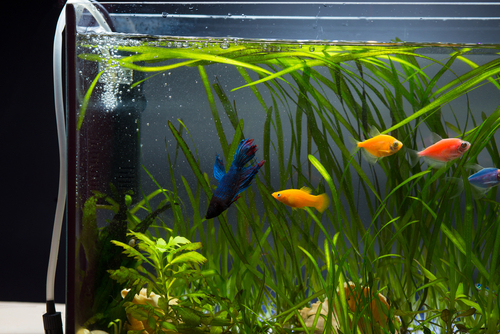Check out these other popular picks in this category:
- How to Clean a Fish Tank
- Tips for Building an Underwater Tunnel
- The Ultimate Guide to Setting Up Your First Fish Tank
Keeping an aquarium can be a fascinating and rewarding experience, allowing you to observe the beauty and serenity of underwater life. However, ensuring the health and well-being of your aquarium fish can be challenging, especially for beginners.
In this article, we will provide you with ten essential tips to keep your aquarium fish alive and healthy and create a thriving aquatic environment.
From water quality mastery to the art of fish selection, we’ll equip you with the knowledge and skills necessary to ensure the well-being of your aquatic companions.
By following these practical guidelines, you can enjoy a successful and enjoyable fishkeeping experience.
Contents
Tips To Keep Your Aquarium Fish Alive and Thriving

1. Understand the Nitrogen Cycle:
Before introducing any fish to your aquarium, it’s crucial to understand the nitrogen cycle. The nitrogen cycle is a natural process that establishes a balance of beneficial bacteria in your tank, converting toxic ammonia into less harmful compounds.
Research the nitrogen cycle to ensure your aquarium is fully cycled before adding fish. This process may take several weeks, but it is crucial for the long-term health of your fish.
2. Implement Regular Water Changes:
Maintaining clean and stable water conditions is essential for the health of your aquarium fish. Perform regular water changes to remove accumulated toxins and excess nutrients and maintain optimal water quality.
Aim for a weekly water change of 25-50%, depending on the size of your tank, as well as the amount of fish in the tank, which has a direct effect on the “bio-load” of your aquarium. Be sure to use a de-chlorinator to neutralize any harmful chemicals in tap water before adding it to the tank.
3. Avoid Overfeeding:

Overfeeding is a common mistake that can lead to poor water quality and health issues for your fish. Remember that fish have small stomachs and do not require large amounts of food.
Feed your fish in small portions, only what they can consume in a few minutes.
Observe their feeding behaviour and adjust the amount accordingly. Overfeeding can result in uneaten food sinking to the bottom, leading to ammonia spikes and deteriorating water conditions.
4. Maintain Consistent Water Parameters:
Aquarium fish thrive in specific water conditions; sudden fluctuations can be stressful and harmful. Invest in a reliable water test kit to monitor essential parameters such as ammonia, nitrite, nitrate, pH, and temperature.
Regularly test these parameters and adjust as needed to maintain stable and suitable conditions for your fish. Get to a point where you can detect an issue by observing your fish and preventing the problem before it becomes severe, and then use your test kit when in doubt.
5. Provide Sufficient Filtration:

Adequate filtration is crucial for maintaining water quality and the overall well-being of your fish. Choose a filter appropriate for your tank size and the number of fish you have.
The filter should provide mechanical, biological, and chemical filtration to remove debris, toxins, and excess nutrients.
Regularly clean or replace filter media according to the manufacturer’s instructions to ensure optimal filtration efficiency.
A good rule of thumb is to choose a filter that is capable of turning over the entire volume of water in your tank at least twice in every hour.
6. Choose Compatible Tank Mates:
When selecting fish for your aquarium, consider the compatibility of different species. Not all fish get along; some may exhibit aggressive or territorial behavior.
Research the temperament, size, and dietary requirements of the fish you plan to keep and choose compatible tank mates that will live harmoniously together. Refrain from impulse buying. This always ends poorly.
A peaceful and stress-free environment promotes better health and reduces the likelihood of injuries or disease.
7. Decorate the Aquarium Appropriately:

Creating a suitable environment for your fish involves providing appropriate decorations and hiding spots. Use aquarium plants, rocks, caves, and driftwood to mimic their natural habitat and provide shelter.
The right decorations not only enhance the aesthetics of your aquarium but also give your fish a sense of security and reduce stress.
8. Quarantine New Fish:
Introducing new fish to your aquarium without quarantine can risk spreading diseases and parasites to your existing fish. Before adding new fish to your main tank, quarantine them separately for a few weeks.
Observe their behavior and monitor their health during this period. If you observe signs of illness or disease, you can treat them in isolation, preventing the spread to other fish.
9. Handle Filters with Care:
Filters play a crucial role in maintaining water quality, but they can also be a source of harm to your fish. When performing maintenance or cleaning the filter, be cautious not to harm or stress your fish.
Please turn off the filter before working on it to avoid accidental injury to your fish or damage to the filter itself.
10. Seek Knowledge and Learn:

Aquarium keeping is a continuous learning process. Stay curious and seek knowledge from reputable sources. Watch informative videos, read books, join online forums, and connect with experienced hobbyists.
Share your experiences, ask questions, and keep an open mind. As you deepen your understanding, you’ll be better equipped to provide the best care for your aquarium fish.
Creating a Relaxing Aquarium Environment To Keep Your Fish Alive and Thriving

Creating an atmosphere in which your aquatic buddies can thrive is just as important to improving their well-being as the physical features of the tank. Here, we go over how to keep your fish alive and healthy in an environment that is both tranquil and calming for them.
- Lighting for Relaxation
Not only does proper illumination bring out the beauty of your underwater environment, but it also significantly improves the general health of your fish. Invest in LED aquarium lights that allow you to change the hue to create a peaceful environment that supports the health and vitality of your fish.
- Choose Calming Colors
The serenity of your aquatic sanctuary can be greatly influenced by the color scheme you choose for your aquarium’s décor. When introducing new fish to your tank, choose mellow colors like light blues, calming greens, and earthy tones to create a peaceful underwater haven for your fish.
- Maintain Peaceful Surroundings
It’s vital to learn how to keep a fish alive, safe and comfortable by making their environment as stress-free as possible. Place your aquarium in a quiet, low-traffic place to reduce noise and other disturbances that can harm your fish. You can keep your fish alive and well in an environment that you establish for them by keeping your tank in a peaceful location.
FAQs on How to Keep Your Fish Alive and Thriving
What is the best way to introduce new fish to an aquarium to ensure their survival?
Introducing new fish to your tank should be a gradual process. You should use a quarantine tank to acclimate them to the water conditions in your main aquarium. This would help you to minimize stress and the risk of diseases, ensuring a smoother transition.
How can I maintain water quality and provide what fish need to survive in my aquarium?
Regular water testing, filtration, and proper maintenance are key. We recommend keeping the water parameters within the optimal range for your specific fish species to ensure their health and longevity.
What are the essential steps to keep your fish alive and thriving in a fish tank?
Key steps on how to keep your fish alive and healthy include:
- Selecting an appropriate tank size
- Maintaining water quality
- Cycling your tank
- Providing proper lighting
- Aquascaping carefully
- Choosing compatible fish
- Practicing proper feeding
- Regular maintenance
- Observing your fish
- Quarantining new additions
How can I keep fish alive in a fish tank and avoid common pitfalls?
To keep your fish alive in a fish tank, focus on the fundamentals: provide a suitable environment, maintain water quality, feed them appropriately, and keep an eye on their health. As long as you avoid overfeeding, overcrowding, and introducing incompatible fish to your tank, your fish will live their best lives.
Final Thoughts
Keeping your aquarium fish alive and thriving requires knowledge, dedication, and a little bit of patience.
By understanding the nitrogen cycle, implementing regular maintenance, avoiding overfeeding, ensuring safety around the aquarium, testing water parameters, observing your fish, selecting compatible tank mates, handling filters with care, providing an appropriately sized tank, and continuously learning, you can create a vibrant and healthy aquarium ecosystem.
Remember to enjoy the journey and appreciate the beauty and joy that aquarium fish bring into your life. Happy fishkeeping!

Veteran fish keeper and keen hobbyist with a serious case of MTS. My midlife crisis was the establishment of a fish room, much to my wife’s horror. Little does she know it could be worse!!


